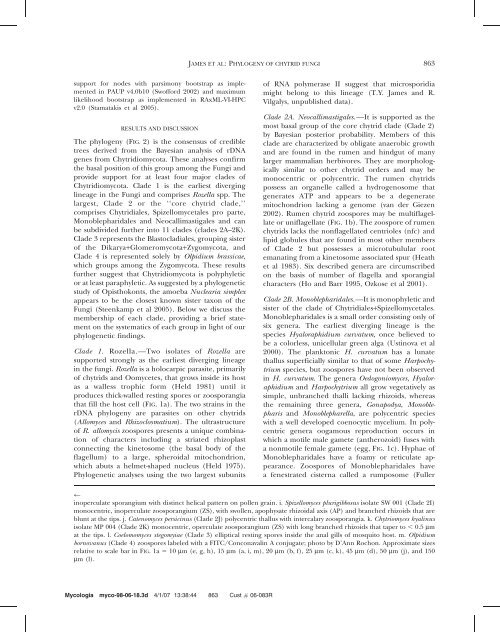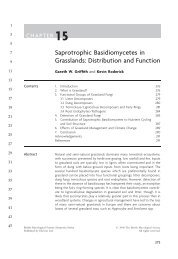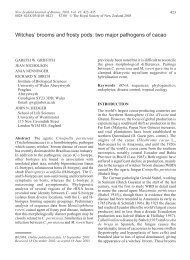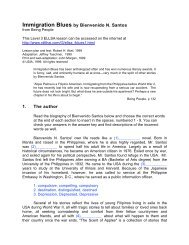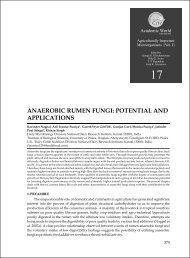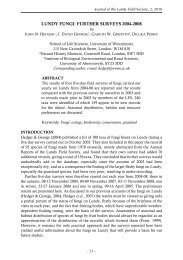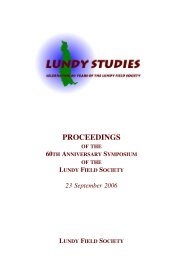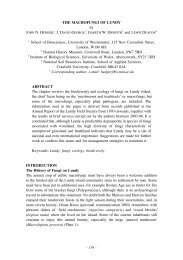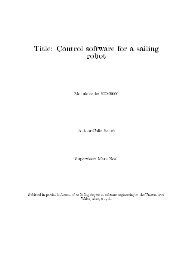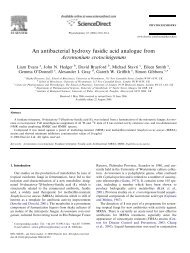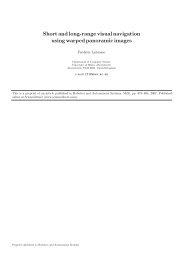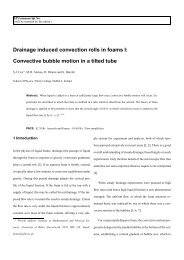Chytridiomycota - Users Site
Chytridiomycota - Users Site
Chytridiomycota - Users Site
Create successful ePaper yourself
Turn your PDF publications into a flip-book with our unique Google optimized e-Paper software.
support for nodes with parsimony bootstrap as implemented<br />
in PAUP v4.0b10 (Swofford 2002) and maximum<br />
likelihood bootstrap as implemented in RAxML-VI-HPC<br />
v2.0 (Stamatakis et al 2005).<br />
RESULTS AND DISCUSSION<br />
The phylogeny (FIG. 2) is the consensus of credible<br />
trees derived from the Bayesian analysis of rDNA<br />
genes from <strong>Chytridiomycota</strong>. These analyses confirm<br />
the basal position of this group among the Fungi and<br />
provide support for at least four major clades of<br />
<strong>Chytridiomycota</strong>. Clade 1 is the earliest diverging<br />
lineage in the Fungi and comprises Rozella spp. The<br />
largest, Clade 2 or the ‘‘core chytrid clade,’’<br />
comprises Chytridiales, Spizellomycetales pro parte,<br />
Monoblepharidales and Neocallimastigales and can<br />
be subdivided further into 11 clades (clades 2A–2K).<br />
Clade 3 represents the Blastocladiales, grouping sister<br />
of the Dikarya+Glomeromycota+Zygomycota, and<br />
Clade 4 is represented solely by Olpidium brassicae,<br />
which groups among the Zygomycota. These results<br />
further suggest that <strong>Chytridiomycota</strong> is polyphyletic<br />
or at least paraphyletic. As suggested by a phylogenetic<br />
study of Opisthokonts, the amoeba Nuclearia simplex<br />
appears to be the closest known sister taxon of the<br />
Fungi (Steenkamp et al 2005). Below we discuss the<br />
membership of each clade, providing a brief statement<br />
on the systematics of each group in light of our<br />
phylogenetic findings.<br />
Clade 1. Rozella.—Two isolates of Rozella are<br />
supported strongly as the earliest diverging lineage<br />
in the fungi. Rozella is a holocarpic parasite, primarily<br />
of chytrids and Oomycetes, that grows inside its host<br />
as a walless trophic form (Held 1981) until it<br />
produces thick-walled resting spores or zoosporangia<br />
that fill the host cell (FIG. 1a). The two strains in the<br />
rDNA phylogeny are parasites on other chytrids<br />
(Allomyces and Rhizoclosmatium). The ultrastructure<br />
of R. allomycis zoospores presents a unique combination<br />
of characters including a striated rhizoplast<br />
connecting the kinetosome (the basal body of the<br />
flagellum) to a large, spheroidal mitochondrion,<br />
which abuts a helmet-shaped nucleus (Held 1975).<br />
Phylogenetic analyses using the two largest subunits<br />
Mycologia myco-98-06-18.3d 4/1/07 13:38:44 863 Cust # 06-083R<br />
JAMES ET AL: PHYLOGENY OF CHYTRID FUNGI 863<br />
of RNA polymerase II suggest that microsporidia<br />
might belong to this lineage (T.Y. James and R.<br />
Vilgalys, unpublished data).<br />
Clade 2A. Neocallimastigales.—It is supported as the<br />
most basal group of the core chytrid clade (Clade 2)<br />
by Bayesian posterior probability. Members of this<br />
clade are characterized by obligate anaerobic growth<br />
and are found in the rumen and hindgut of many<br />
larger mammalian herbivores. They are morphologically<br />
similar to other chytrid orders and may be<br />
monocentric or polycentric. The rumen chytrids<br />
possess an organelle called a hydrogenosome that<br />
generates ATP and appears to be a degenerate<br />
mitochondrion lacking a genome (van der Giezen<br />
2002). Rumen chytrid zoospores may be multiflagellate<br />
or uniflagellate (FIG. 1b). The zoospore of rumen<br />
chytrids lacks the nonflagellated centrioles (nfc) and<br />
lipid globules that are found in most other members<br />
of Clade 2 but possesses a microtubulular root<br />
emanating from a kinetosome associated spur (Heath<br />
et al 1983). Six described genera are circumscribed<br />
on the basis of number of flagella and sporangial<br />
characters (Ho and Barr 1995, Ozkose et al 2001).<br />
Clade 2B. Monoblepharidales.—It is monophyletic and<br />
sister of the clade of Chytridiales+Spizellomycetales.<br />
Monoblepharidales is a small order consisting only of<br />
six genera. The earliest diverging lineage is the<br />
species Hyaloraphidium curvatum, once believed to<br />
be a colorless, unicellular green alga (Ustinova et al<br />
2000). The planktonic H. curvatum has a lunate<br />
thallus superficially similar to that of some Harpochytrium<br />
species, but zoospores have not been observed<br />
in H. curvatum. The genera Oedogoniomyces, Hyaloraphidium<br />
and Harpochytrium all grow vegetatively as<br />
simple, unbranched thalli lacking rhizoids, whereas<br />
the remaining three genera, Gonapodya, Monoblepharis<br />
and Monoblepharella, are polycentric species<br />
with a well developed coenocytic mycelium. In polycentric<br />
genera oogamous reproduction occurs in<br />
which a motile male gamete (antherozoid) fuses with<br />
a nonmotile female gamete (egg, FIG. 1c). Hyphae of<br />
Monoblepharidales have a foamy or reticulate appearance.<br />
Zoospores of Monoblepharidales have<br />
a fenestrated cisterna called a rumposome (Fuller<br />
r<br />
inoperculate sporangium with distinct helical pattern on pollen grain. i. Spizellomyces plurigibbosus isolate SW 001 (Clade 2I)<br />
monocentric, inoperculate zoosporangium (ZS), with swollen, apophysate rhizoidal axis (AP) and branched rhizoids that are<br />
blunt at the tips. j. Catenomyces persicinus (Clade 2J) polycentric thallus with intercalary zoosporangia. k. Chytriomyces hyalinus<br />
isolate MP 004 (Clade 2K) monocentric, operculate zoosporangium (ZS) with long branched rhizoids that taper to , 0.5 mm<br />
at the tips. l. Coelomomyces stegomyiae (Clade 3) elliptical resting spores inside the anal gills of mosquito host. m. Olpidium<br />
bornovanus (Clade 4) zoospores labeled with a FITC/Conconavalin A conjugate; photo by D’Ann Rochon. Approximate sizes<br />
relative to scale bar in FIG. 1a5 10 mm (e, g, h), 15 mm (a, i, m), 20 mm (b, f), 25 mm (c, k), 45 mm (d), 50 mm (j), and 150<br />
mm (l).


